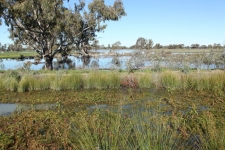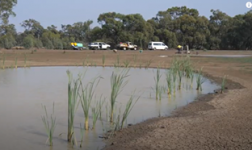2 March 2022
News
Floodplain heroes – Bringing back the bittern at Murrabit West
Meet Ken and Jill Hooper who are restoring a complex of wetlands on their 155-hectare property at Murrabit West.
Ken and Jill Hooper are returning their property to a series of wetlands surrounded by bushland and open grasses. They put a Trust for Nature covenant on this ‘run out block’ of their former Cohuna dairy farm back in 2008. They’ve been working tirelessly ever since to restore the wetland habitat, replicating different types of floodplain habitats, such as deep creeks, shallow areas, shallow timbered areas, and shallow lignum.
“Jill and I both love natural areas and nature, especially birdlife,” explained Ken. “We despair at some of the wetland destruction that has occurred and is still occurring. We want to put something back into the country that has given us our livelihood and preserve something for the generations that come after us.”

Wirra-lo wetlands complex in Murrabit West
Thanks to a partnership with North Central CMA, the Hoopers were able to secure environmental water under a ten-year restoration and management strategy.
So much has been achieved over the past decade. “The Growling Grass Frog had not been recorded in this region since 2008. It was the pinnacle of our plan and they have turned up again. The property is noted for frogs generally; for some reason they love it,” said Ken. “They breed in their millions.”
Waterfowls feed in the area, while other species come to breed, such as crake, rails and a few duck species.
In 2019, Ken and Jill’s site was chosen for the Bringing back the Bittern project – a project run by North Central CMA with funding from the Australian Government National Landcare Program to increase habitat for this endangered bird.
The Hoopers worked closely with North Central CMA to create two wetland areas designed specially to attract Bitterns for breeding. This included planting reed beds for nesting and creating some open areas for foraging with herbs and grasses and sedges.

Reeds were planted at Bunyip Swamp West to provide nesting sites for Bitterns back in 2019
“It takes about five years for the area to blossom into a fully functional wetland ecosystem suitable for bitterns, waterbirds and frogs.” said Ken. “We see this as a very special place and we are looking forward to seeing Bitterns on our land.”
“Wetlands are like the lungs of the landscape,” added Ken. “They have a big part to play in keeping our water supply clean, storing carbon and keeping our birdlife abundant.”
“We want a legacy and we want this property to serve as an example of environmental stewardship.,” he added.



 Chris Tzaros@Birds Bush and Beyond
Chris Tzaros@Birds Bush and Beyond